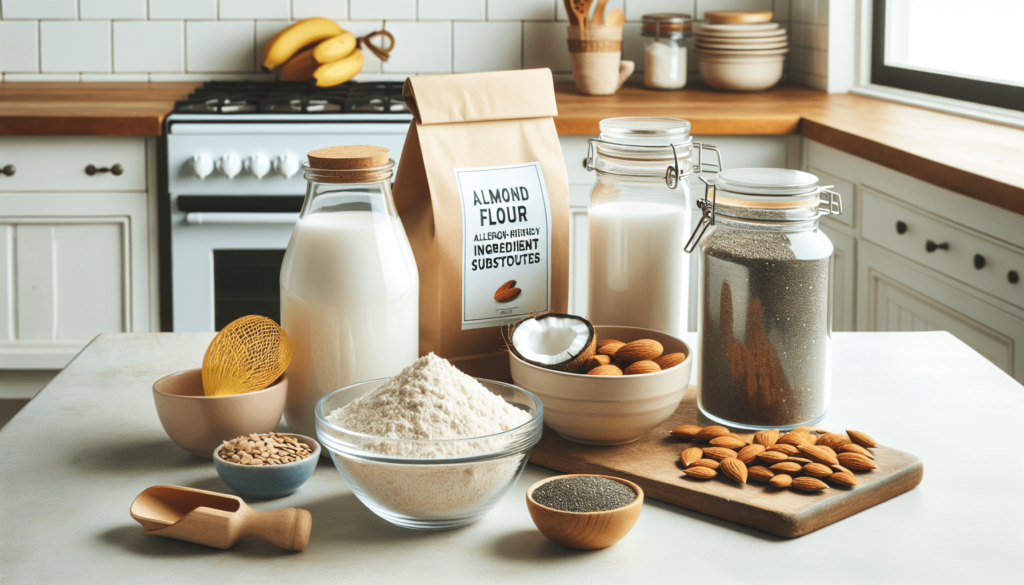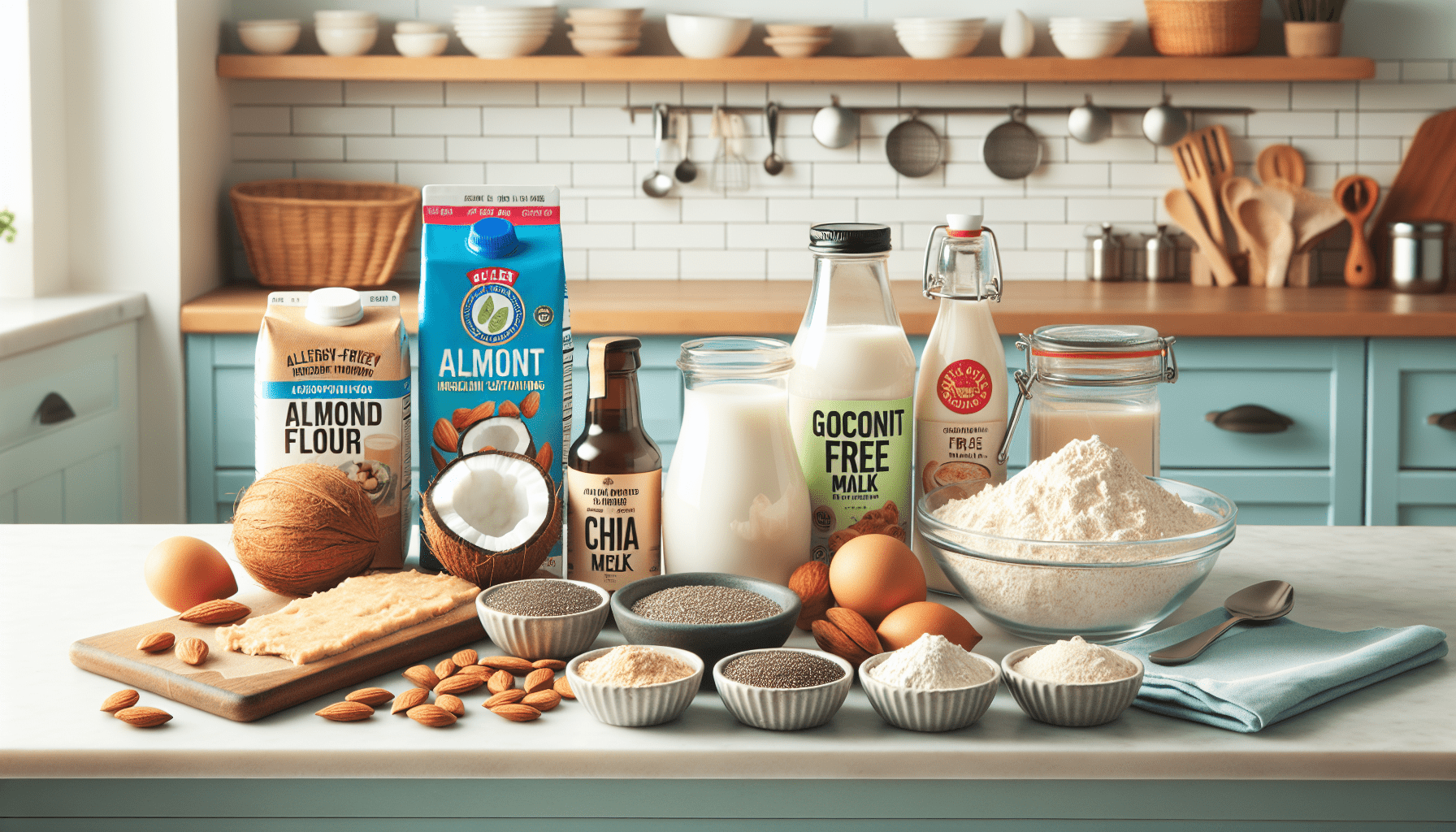Do you or someone you know suffer from food allergies? Navigating the world of cooking and baking can be challenging when allergies are a concern, but don’t worry! With a little knowledge and some handy substitutions, you can create delicious and safe meals for everyone to enjoy.
Understanding Food Allergies
Food allergies are your body’s immune response to certain foods. The most common allergens include peanuts, tree nuts, dairy, eggs, soy, wheat, fish, and shellfish. When someone with a food allergy consumes an allergen, their body reacts, which can range from mild symptoms like itching and hives to severe reactions like anaphylaxis.
Common Food Allergies
Here’s a table of the most common food allergies and some of the typical reactions they cause.
| Allergen | Common Reactions |
|---|---|
| Peanuts | Hives, swelling, anaphylaxis |
| Tree Nuts | Nausea, anaphylaxis |
| Dairy | Digestive issues, hives, anaphylaxis |
| Eggs | Skin reactions, respiratory issues |
| Soy | Digestive trouble, hives |
| Wheat/Gluten | Digestive issues, skin reactions |
| Fish | Skin reactions, hives, anaphylaxis |
| Shellfish | Respiratory problems, anaphylaxis |
Understanding these allergens is the first step toward making allergy-friendly meals.
Substituting Common Allergens in Cooking and Baking
When you’re cooking or baking for someone with allergies, substitutions are crucial. Finding the right replacement that maintains the texture, flavor, and integrity of the dish can be tricky, but it’s definitely achievable.
Dairy Substitutes
Dairy isn’t just milk; it includes yogurt, cheese, and butter. Here are some common replacements:
- Milk: Use almond, soy, rice, or oat milk. These alternatives work well in both sweet and savory dishes.
- Yogurt: Coconut yogurt or soy yogurt are great substitutes.
- Cheese: Nutritional yeast or plant-based cheeses can replace cheese in recipes.
- Butter: Dairy-free butter or margarine, coconut oil, or olive oil are excellent choices.
Here’s a quick reference table for dairy substitutions:
| Dairy Product | Suggested Substitute |
|---|---|
| Milk | Almond milk, soy milk, rice milk |
| Yogurt | Coconut yogurt, soy yogurt |
| Cheese | Nutritional yeast, plant-based cheeses |
| Butter | Dairy-free butter, coconut oil, olive oil |
Egg Substitutes
Eggs serve many functions in recipes, from binding to leavening. Depending on their purpose, different substitutes can be used.
- Binding: Flaxseed or chia seeds mixed with water, mashed bananas, or applesauce.
- Leavening: Baking powder mixed with vinegar or sparkling water.
- Moisture: Silken tofu or yogurt alternatives work well.
Here’s a table to help you with egg substitutions:
| Egg’s Role | Substitute |
|---|---|
| Binding | Flaxseed/water mix, chia seed/water mix |
| Leavening | Baking powder + vinegar, sparkling water |
| Moisture | Silken tofu, applesauce |
Wheat and Gluten Substitutes
People with gluten intolerance or celiac disease need to avoid wheat and other gluten-containing grains. Fortunately, there are several great alternatives:
- Flour: Use gluten-free flours like almond flour, coconut flour, rice flour, or a gluten-free flour blend.
- Pasta: Rice pasta, quinoa pasta, or spiralized vegetables are great substitutes.
- Bread: Gluten-free bread available in most grocery stores or homemade gluten-free bread.
Here’s a concise table for wheat and gluten substitutions:
| Wheat Product | Suggested Substitute |
|---|---|
| Flour | Almond flour, coconut flour, rice flour |
| Pasta | Rice pasta, quinoa pasta, zoodles |
| Bread | Gluten-free bread |
Nut Substitutes
Nut allergies are among the most common and can be severe. Here are some alternatives:
- Peanuts: Sunflower seed butter or soy nut butter.
- Tree Nuts: Seeds like pumpkin or sunflower seeds work well.
- Almond Flour: Substitute with oat flour or coconut flour.
Here’s a quick reference for nut substitutions:
| Nut Product | Suggested Substitute |
|---|---|
| Peanuts | Sunflower seed butter, soy nut butter |
| Tree Nuts | Pumpkin seeds, sunflower seeds |
| Almond Flour | Oat flour, coconut flour |
Soy Substitutes
Soy is frequently found in processed foods, making it a tricky allergen to avoid. Here are some alternatives:
- Soy Sauce: Coconut aminos or tamari sauce.
- Tofu and Tempeh: For protein, use beans, lentils, or quinoa.
- Edamame: Use green peas or snap peas.
Here’s a helpful table for soy substitutions:
| Soy Product | Suggested Substitute |
|---|---|
| Soy Sauce | Coconut aminos, tamari sauce |
| Tofu/Tempeh | Beans, lentils, quinoa |
| Edamame | Green peas, snap peas |
Fish and Shellfish Substitutes
When it comes to fish and shellfish allergies, finding substitutes can be challenging, especially for dishes that rely heavily on seafood. Here are some ideas:
- Fish: Tofu, tempeh, or plant-based fish alternatives.
- Shellfish: Mushrooms or a vegan seafood blend.
Here’s a substitution table for fish and shellfish:
| Seafood Product | Suggested Substitute |
|---|---|
| Fish | Tofu, tempeh, plant-based fish |
| Shellfish | Mushrooms, vegan seafood blend |

Tips for Allergy-Friendly Cooking and Baking
Substituting ingredients is half the battle. Here are some tips to ensure your allergy-friendly dishes are a hit.
Read Labels Meticulously
Always check ingredient labels, even on products you wouldn’t expect to contain allergens. Manufacturers sometimes change recipes without notice, and cross-contamination can occur.
Clean Your Cooking Space
Cross-contamination is a serious risk in shared kitchens. Clean all surfaces, utensils, and cookware thoroughly. Consider having separate items for allergy-friendly cooking if needed.
Communicate Clearly
If you’re cooking for someone else, ask about their allergies and any specific substitutes they’ve found to work well. Clear communication can prevent accidents and ensure the dish meets their needs.
Experiment with Recipes
Finding the right balance can take some trial and error. Don’t be disheartened if a recipe doesn’t turn out perfect the first time. With practice, you’ll become more comfortable with substitutions.
Be Cautious with New Ingredients
Introduce new substitutes gradually, as some individuals might have multiple allergies. It’s wise to test a small portion first to ensure there’s no adverse reaction.
Delicious Allergy-Friendly Recipes to Try
To get you started, here are a few simple recipes that use the substitutions mentioned above.
Dairy-Free Chocolate Chip Cookies
Ingredients:
- 2 ½ cups gluten-free flour blend
- 1 tsp baking soda
- 1 tsp salt
- 1 cup coconut oil (solid)
- ¾ cup sugar
- ¾ cup brown sugar
- 1 tsp vanilla extract
- 2 flax eggs (2 tbsp ground flaxseed + 6 tbsp water)
- 2 cups dairy-free chocolate chips
Instructions:
- Preheat your oven to 375°F (190°C).
- Mix the ground flaxseed with water and set aside for 5 minutes to form the flax eggs.
- In a bowl, combine the flour, baking soda, and salt.
- In a separate bowl, beat the coconut oil, sugar, brown sugar, and vanilla extract until creamy.
- Add the flax eggs into the wet mixture and blend.
- Gradually add the dry ingredients into the wet mixture.
- Fold in the dairy-free chocolate chips.
- Drop spoonfuls of dough onto a baking sheet.
- Bake for 9-11 minutes until edges are golden brown.
- Let cool before serving.
Gluten-Free, Vegan Banana Bread
Ingredients:
- 3 ripe bananas, mashed
- ½ cup coconut oil
- ½ cup brown sugar
- 2 flax eggs (2 tbsp ground flaxseed + 6 tbsp water)
- 1 tsp vanilla extract
- 1 ½ cups gluten-free flour blend
- 1 tsp baking soda
- ½ tsp salt
- 1 tsp cinnamon
Instructions:
- Preheat your oven to 350°F (175°C). Grease a loaf pan.
- Mix the ground flaxseed with water and set aside for 5 minutes.
- In a large bowl, combine mashed bananas, coconut oil, brown sugar, flax eggs, and vanilla extract.
- In another bowl, mix the gluten-free flour, baking soda, salt, and cinnamon.
- Slowly add the dry ingredients to the wet mixture until well combined.
- Pour the batter into the greased loaf pan.
- Bake for 50-60 minutes or until a toothpick comes out clean.
- Allow to cool before slicing.
Egg-Free, Dairy-Free Pancakes
Ingredients:
- 1 cup oat milk
- 1 tbsp apple cider vinegar
- 1 cup gluten-free flour blend
- 2 tbsp sugar
- 1 tbsp baking powder
- ¼ tsp salt
- 2 tbsp coconut oil (melted)
- 1 tsp vanilla extract
Instructions:
- In a small bowl, combine oat milk and apple cider vinegar. Set aside for a few minutes to create a “buttermilk” substitute.
- In a large bowl, mix the flour, sugar, baking powder, and salt.
- Add the coconut oil and vanilla extract to the “buttermilk” mixture.
- Combine the wet ingredients with the dry ingredients, stirring until just combined.
- Heat a non-stick skillet over medium heat and lightly grease it.
- Pour ¼ cup of batter onto the skillet for each pancake.
- Cook until bubbles form on the surface, then flip and cook until golden brown.
- Serve warm with your favorite toppings.
Soy-Free Stir Fry
Ingredients:
- 2 cups mixed vegetables (broccoli, bell peppers, carrots)
- 1 cup cooked quinoa
- 1 package firm tofu (pressed and cubed)
- 2 tbsp coconut oil
- ¼ cup coconut aminos
- 1 tbsp fresh ginger (grated)
- 2 cloves garlic (minced)
- 1 tbsp cornstarch mixed with 2 tbsp water
- Green onions (sliced, for garnish)
Instructions:
- Heat the coconut oil in a large pan over medium heat.
- Add the tofu cubes and cook until golden brown on all sides. Remove and set aside.
- In the same pan, add the mixed vegetables and cook until tender.
- Add the cooked quinoa and tofu back to the pan.
- Pour in the coconut aminos, ginger, and garlic, stirring well.
- Add the cornstarch mixture to the pan and cook until the sauce thickens.
- Garnish with green onions before serving.

Additional Resources and Final Thoughts
Cooking and baking while accommodating allergies can feel overwhelming at first but becomes more manageable as you familiarize yourself with the best substitutes and practices. There are plenty of resources online, such as allergy-friendly cookbooks and specialized food blogs, which can provide more recipes and tips.
Allergy-friendly cooking ensures that everyone at your table feels safe, included, and delighted by the meal. The effort you put into learning and adapting your favorite dishes will be greatly appreciated by those with dietary restrictions. So, embrace the challenge and enjoy the journey of discovering new ingredients and creative solutions.
If you ever feel unsure, don’t hesitate to do further research or consult with a dietitian who can provide additional guidance tailored to specific needs. Happy cooking!
